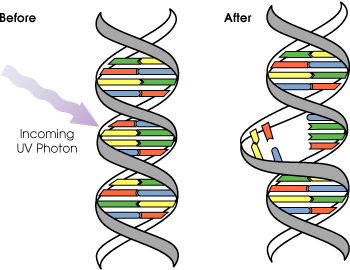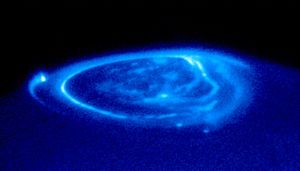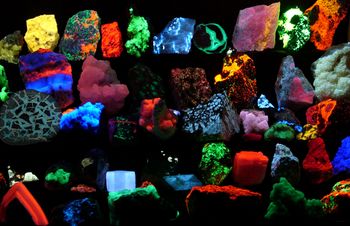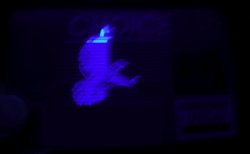Ultraviolet
2007 Schools Wikipedia Selection. Related subjects: General Physics
Ultraviolet (UV) light is electromagnetic radiation with a wavelength shorter than that of visible light, but longer than soft X-rays. It can be subdivided into near UV (380–200 nm wavelength; abbrev. NUV), far or vacuum UV (200–10 nm; abbrev. FUV or VUV), and extreme UV (1–31 nm; abbrev. EUV or XUV).
Origin of term
The name means "beyond violet" (from Latin ultra, "beyond"), violet being the colour of the shortest wavelengths of visible light.
Discovery
Soon after infrared radiation had been discovered, the German physicist Johann Wilhelm Ritter began to look for radiation at the opposite end of the spectrum, at the short wavelengths beyond violet. In 1801 he used silver chloride, a light-sensitive chemical, to show that there was a type of invisible light beyond violet, which he called chemical rays. At that time, many scientists, including Ritter, concluded that light was composed of three separate components: an oxidising or calorific component (infrared), an illuminating component (visible light), and a reducing or hydrogenating component (ultraviolet). The unity of the different parts of the spectrum was not understood until about 1842, with the work of Macedonio Melloni, Alexandre-Edmond Becquerel and others. During that time, UV radiation was also called "actinic radiation".
Explanation
When considering the effect of UV radiation on human health and the environment, the range of UV wavelengths is often subdivided into UVA (400–315 nm), also called Long Wave or "blacklight"; UVB (315–280 nm), also called Medium Wave; and UVC (< 280 nm), also called Short Wave or "germicidal". See 1 E-7 m for a list of objects of comparable sizes.
In photolithography, in laser technology, etc., the term deep ultraviolet or DUV refers to wavelengths below 300 nm.
Some of the UV wavelengths are colloquially called black light, as it is invisible to the human eye. Some animals, including birds, reptiles, and insects such as bees, can see into the near ultraviolet. Many fruits, flowers, and seeds stand out more strongly from the background in ultraviolet wavelengths as compared to human colour vision. Scorpions glow or take on a yellow to green colour under UV illumination. Many birds have patterns in their plumage that are invisible at usual wavelengths but observable in ultraviolet, and the urine of some animals is much easier to spot with ultraviolet.
Safety aspects of UV
In humans, prolonged exposure to solar UV radiation may result in acute and chronic health effects on the skin, eye, and immune system.
UVC rays are the highest energy, most dangerous type of ultraviolet light. Little attention has been given to UVC rays in the past since they are filtered out by the atmosphere. However, their use in equipment such as pond sterilization units may pose an exposure risk, if the lamp is switched on outside of its enclosed pond sterilization unit.

Skin
| Ultraviolet (UV) irradiation present in sunlight is an environmental human carcinogen. The toxic effects of UV from natural sunlight and therapeutic artificial lamps are a major concern for human health. The major acute effects of UV irradiation on normal human skin comprise sunburn inflammation (erythema), tanning, and local or systemic immunosuppression. | ||
|
— Matsumura, Y. & Ananthaswamy H. N. , Toxicology and Applied Pharmacology (2004)
|
UVA, UVB and UVC can all damage collagen fibers and thereby accelerate aging of the skin. In general, UVA is the least harmful, but can contribute to the aging of skin, DNA damage and possibly skin cancer. It penetrates deeply and does not cause sunburn. Because it does not cause reddening of the skin (erythema) it cannot be measured in the SPF testing. There is no good clinical measurement of the blocking of UVA radiation, but it is important that sunscreen block both UVA and UVB.
UVA light is also known as "dark-light" and, because of its longer wavelength, can penetrate most windows. It also penetrates deeper into the skin than UVB light and is thought to be a prime cause of wrinkles.
UVB light can cause skin cancer. The radiation excites DNA molecules in skin cells, causing covalent bonds to form between adjacent thymine bases, producing thymidine dimers. Thymidine dimers do not base pair normally, which can cause distortion of the DNA helix, stalled replication, gaps, and misincorporation. These can lead to mutations, which can result in cancerous growths. The mutagenicity of UV radiation can be easily observed in bacteria cultures. This cancer connection is one reason for concern about ozone depletion and the ozone hole.
As a defense against UV radiation, the body tans when exposed to moderate (depending on skin type) levels of radiation by releasing the brown pigment melanin. This helps to block UV penetration and prevent damage to the vulnerable skin tissues deeper down. Suntan lotion that partly blocks UV is widely available (often referred to as "sun block" or " sunscreen"). Most of these products contain an "SPF rating" that describes the amount of protection given. This protection, however, applies only to UVB rays responsible for sunburn and not to UVA rays that penetrate more deeply into the skin and may also be responsible for causing cancer and wrinkles. Some sunscreen lotion now includes compounds such as titanium dioxide which helps protect against UVA rays. Other UVA blocking compounds found in sunscreen include zinc oxide and avobenzone. There are also naturally occurring compounds found in rainforest plants that have been known to protect the skin from UV radiation damage, such as the fern Polypodium leucotomos.
What to look for in sunscreen:
UVB protection: Padimate O, Homosalate, Octisalate ( octyl salicylate), Octinoxate ( octyl methoxycinnamate)
UVA protection: Avobenzone
UVA/UVB protection: Octocrylene, titanium dioxide, zinc oxide, Mexoryl ( ecamsule)
Another means to block UV is sun protective clothing. This is clothing that has a "UPF rating" that describes the protection given against both UVA and UVB.
Eye
High intensities of UVB light are hazardous to the eyes, and exposure can cause welder's flash ( photokeratitis or arc eye) and may lead to cataracts, pterygium , and pinguecula formation.
Protective eyewear is beneficial to those who are working with or those who might be exposed to ultraviolet radiation, particularly short wave UV. Given that light may reach the eye from the sides, full coverage eye protection is usually warranted if there is an increased risk of exposure, as in high altitude mountaineering. Mountaineers are exposed to higher than ordinary levels of UV radiation, both because there is less atmospheric filtering and because of reflection from snow and ice.
Ordinary, untreated eyeglasses give some protection. Most plastic lenses give more protection than glass lenses, because, as noted above, glass is transparent to UVA and the common acrlyic plastic used for lenses is less so. Some plastic lens materials, such as polycarbonate, inherently block most UV. There are protective treatments available for eyeglass lenses that need it which will give better protection. But even a treatment that completely blocks UV will not protect the eye from light that arrives around the lens. To convince yourself of the potential dangers of stray UV light, cover your lenses with something opaque, like aluminium foil, stand next to a bright light, and consider how much light you see, despite the complete blockage of the lenses. Most intraocular lenses help to protect the retina by absorbing UV radiation.
Applications of UV
Black lights
A black light is a lamp that emits long wave UV radiation and very little visible light. Fluorescent black lights are typically made in the same fashion as normal fluorescent lights except that only one phosphor is used and the normally clear glass envelope of the bulb is replaced by a deep bluish purple glass called Wood's glass.
To thwart counterfeiters, sensitive documents (e.g. credit cards, driver's licenses, passports) may also include a UV watermark that can only be seen when viewed under a UV-emitting light. Passports issued by most countries usually contain UV sensitive inks and security threads. Visa stamps and stickers such as those issued by Ukraine contain large and detailed seals invisible to the naked eye under normal lights, but strongly visible under UV illimunation. Passports issued by the United States have the UV sensitive threads on the last page of the passport along with the barcode.
Fluorescent lamps
Fluorescent lamps produce UV radiation by ionising low-pressure mercury vapour. A phosphorescent coating on the inside of the tubes absorbs the UV and converts it to visible light.
The main mercury emission wavelength is in the UVC range. Unshielded exposure of the skin or eyes to mercury arc lamps that do not have a conversion phosphor is quite dangerous.
The light from a mercury lamp is predominantly at discrete wavelengths. Other practical UV sources with more continuous emission spectra include xenon arc lamps (commonly used as sunlight simulators), deuterium arc lamps, mercury-xenon arc lamps, metal-halide arc lamps, and tungsten-halogen incandescent lamps.
Astronomy

In astronomy, very hot objects preferentially emit UV radiation (see Wien's law). However, the same ozone layer that protects us causes difficulties for astronomers observing from the Earth, so most UV observations are made from space. (see UV astronomy, space observatory)
Pest control
Ultraviolet fly traps are used for the elimination of various small flying insects. They are attracted to the UV light and are killed using an electrical shock or trapped once they come into contact with the device.
Spectrophotometry
UV/VIS spectroscopy is widely used as a technique in chemistry, for analysis of chemical structure, most notably conjugated systems. UV radiation is often used in visible spectrophotometry to determine the existence of fluorescence a given sample.
Analyzing minerals

Ultraviolet lamps are also used in analyzing minerals, gems, and in other detective work including authentication of various collectibles. Materials may look the same under visible light, but fluoresce to different degrees under ultraviolet light; or may fluoresce differently under short wave ultraviolet versus long wave ultraviolet. UV fluorescent dyes are used in many applications (for example, biochemistry and forensics). The fluorescent protein Green Fluorescent Protein (GFP) is often used in genetics as a marker. Many substances, proteins for instance, have significant light absorption bands in the ultraviolet that are of use and interest in biochemistry and related fields. UV-capable spectrophotometers are common in such laboratories.
Photolithography
Ultraviolet radiation is used for very fine resolution photolithography, a procedure where a chemical known as a photoresist is exposed to UV radiation which has passed through a mask. The light allows chemical reactions to take place in the photoresist, and after development (a step that either removes the exposed or unexposed photoresist), a geometric pattern which is determined by the mask remains on the sample. Further steps may then be taken to "etch" away parts of the sample with no photoresist remaining.
UV radiation is used extensively in the electronics industry because photolithography is used in the manufacture of semiconductors, integrated circuit components and printed circuit boards.
Checking electrical insulation
A new application of UV is to detect corona discharge (often simply called "corona") on electrical apparatus. Degradation of insulation of electrical apparatus or pollution causes corona, wherein a strong electric field ionizes the air and excites nitrogen molecules, causing the emission of ultraviolet radiation. The corona degrades the insulation level of the apparatus. Corona produces ozone and to a lesser extent nitrogen oxide which may subsequently react with water in the air to form nitrous acid and nitric acid vapour in the surrounding air.
Sterilization
Ultraviolet lamps are used to sterilize workspaces and tools used in biology laboratories and medical facilities. Commercially-available low pressure mercury-vapor lamps emit about 86% of their light at 254 nanometers (nm) which coincides very well with one of the two peaks of the germicidal effectiveness curve (i.e., effectiveness for UV absorption by DNA). One of these peaks is at about 265 nm and the other is at about 185 nm. Although 185 nm is better absorbed by DNA, the quartz glass used in commercially-available lamps, as well as environmental media such as water, are more opaque to 185 nm than 254 nm (C. von Sonntag et al., 1992). UV light at these germicidal wavelengths causes adjacent thymine molecules on DNA to dimerize, if enough of these defects accumulate on a microorganism's DNA its replication is inhibited, thereby rendering it harmless (even though the organism may not be killed outright). Since microorganisms can be shielded from ultraviolet light in small cracks and other shaded areas, however, these lamps are used only as a supplement to other sterilization techniques.
Disinfecting drinking water
UV radiation can be an effective viricide and bactericide. Disinfection using UV radiation was more commonly used in wastewater treatment applications but is finding increased usage in drinking water treatment. A process named SODIS has been extensively researched in Switzerland and proven ideal to treat small quantities of water. Contaminated water is filled into transparent plastic bottles and exposed to full sunlight for six hours. The sunlight is treating the contaminated water through two synergetic mechanisms: Radiation in the spectrum of UV-A (wavelength 320-400nm) and increased water temperature. If the water temperatures raises above 50°C, the disinfection process is three times faster. It used to be thought that UV disinfection was more effective for bacteria and viruses, which have more exposed genetic material, than for larger pathogens which have outer coatings or that form cyst states (e.g., Giardia) that shield their DNA from the UV light. However, it was recently discovered that ultraviolet radiation can be somewhat effective for treating the microorganism Cryptosporidium. The findings resulted in two US patents and the use of UV radiation as a viable method to treat drinking water. Giardia in turn has been shown to be very susceptible to UV-C when the tests were based on infectivity rather than excystation. It turns out that protists are able to survive high UV-C doses but are sterilized at low doses.
Food Processing
As consumer demand for fresh and "fresh like" food products increases, the demand for nonthermal methods of food processing is likewise on the rise. In addition, public awareness regarding the dangers of food poisoning is also raising demand for improved food processing methods. Ultraviolet radiation is used in several food processes to remove unwanted microorganisms. UV light can be used to pasteurize fruit juices by flowing the juice over a high intensity ultraviolet light source. The effectiveness of such a process depends on the UV absorbance of the juice (see Beer's law).
Fire detection
Ultraviolet detectors generally use either a solid-state device, such as one based on silicon carbide or aluminium nitride, or a gas-filled tube as the sensing element. UV detectors which are sensitive to UV light in any part of the spectrum respond to irradiation by sunlight and artificial light. A burning hydrogen flame, for instance, radiates strongly in the 185 to 260 nanometer range and only very weakly in the IR region, while a coal fire emits very weakly in the UV band yet very strongly at IR wavelengths; thus a fire detector which operates using both UV and IR detectors is more reliable than one with a UV detector alone. Virtually all fires emit some radiation in the UVB band, while the Sun's radiation at this band is absorbed by the Earth's atmosphere. The result is that the UV detector is "solar blind", meaning it will not cause an alarm in response to radiation from the Sun, so it can easily be used both indoors and outdoors.
UV detectors are sensitive to most fires, including hydrocarbons, metals, sulfur, hydrogen, hydrazine, and ammonia. Arc welding, electrical arcs, lightning, X-rays used in nondestructive metal testing equipment (though this is highly unlikely), and radioactive materials can produce levels that will activate a UV detection system. The presence of UV-absorbing gases and vapors will attenuate the UV radiation from a fire, adversely affecting the ability of the detector to detect flames. Likewise, the presence of an oil mist in the air or an oil film on the detector window will have the same effect.
Curing of adhesives and coatings
Certain adhesives and coatings are formulated with photoinitiators. When exposed to the correct dose and intensity in the required band of UV light, polymerisation occurs, and so the adhesives harden or cure. Usually, this reaction is very quick, a matter of a few seconds. Applications include glass and plastic bonding, optical fibre coatings, the coating of flooring, paper finishes in offset printing, and dental fillings.
Deterring Substance Abuse in Public Places
UV lights have been installed in some parts of the world in public restrooms, and on public transport, for the purpose of deterring substance abuse. The blue colour of these lights, combined with the fluorescence of the skin, make it harder for intravenous drug users to find a vein. The efficacy of these lights for that purpose has been questioned, with some suggesting that drug users simply find a vein outside the public restroom and mark the spot with a marker for accessibility when inside the restroom. There is currently no published evidence supporting the idea of a deterrent effect.
Erasing EPROM modules
Some EPROM (electronically programmable read-only memory) modules are erased by exposure to UV radiation. These modules often have a transparent glass (quartz) window on the top of the chip that allows the UV radiation in. These have been largely superseded by EEPROM and flash memory chips in most devices.
Preparing Low Surface Energy Polymers
UV radiation is useful in preparing low surface energy polymers for adhesives. Polymers exposed to UV light will oxidize thus raising the surface energy of the polymer. Once the surface energy of the polymer has been raised, the bond between the adhesive and the polymer will be greater.
Reading completely illegible papyruses
Using multi-spectral imaging it is possible to read illegible papyruses, such as the burned papyruses of the Villa of the Papyri or of Oxyrhynchus. The technique involves taking pictures of the illegible papyruses using different filters in the infrared or ultraviolet range, finely tuned to capture certain wavelengths of light. Thus, the optimum spectral portion can be found for distinguishing ink from paper on the papyrus surface.


